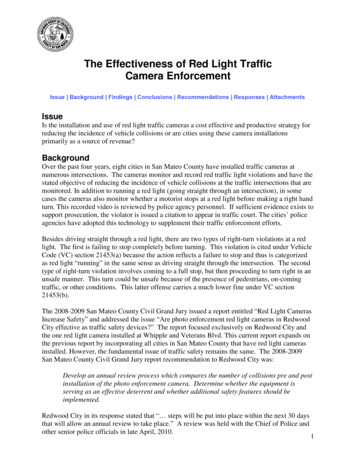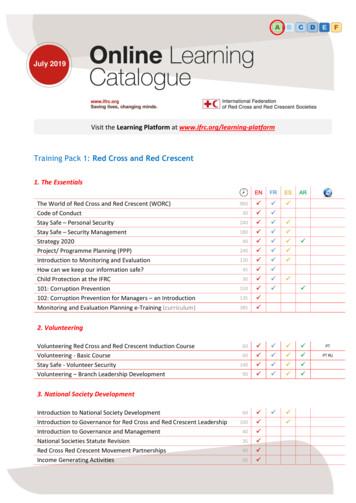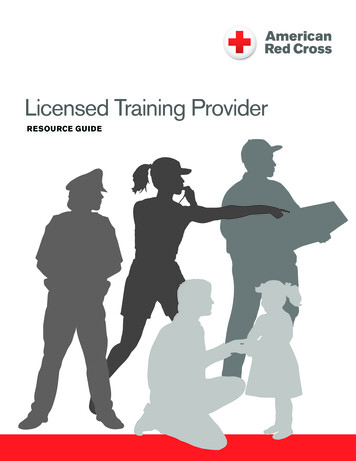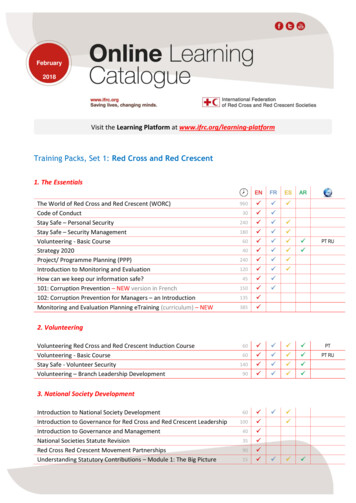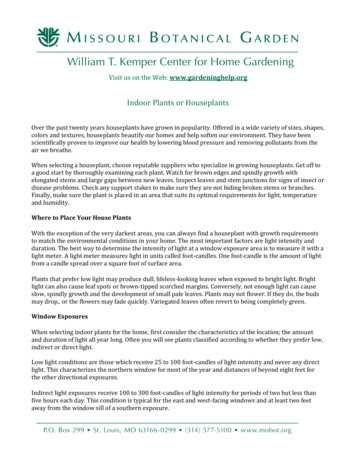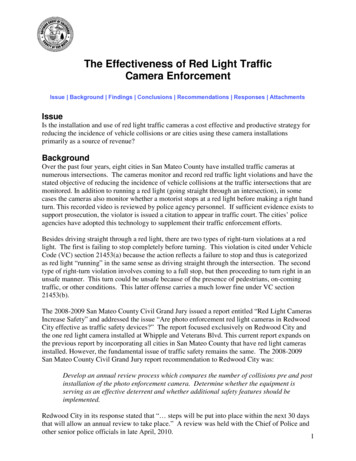
Transcription
The Effectiveness of Red Light TrafficCamera EnforcementIssue Background Findings Conclusions Recommendations Responses AttachmentsIssueIs the installation and use of red light traffic cameras a cost effective and productive strategy forreducing the incidence of vehicle collisions or are cities using these camera installationsprimarily as a source of revenue?BackgroundOver the past four years, eight cities in San Mateo County have installed traffic cameras atnumerous intersections. The cameras monitor and record red traffic light violations and have thestated objective of reducing the incidence of vehicle collisions at the traffic intersections that aremonitored. In addition to running a red light (going straight through an intersection), in somecases the cameras also monitor whether a motorist stops at a red light before making a right handturn. This recorded video is reviewed by police agency personnel. If sufficient evidence exists tosupport prosecution, the violator is issued a citation to appear in traffic court. The cities’ policeagencies have adopted this technology to supplement their traffic enforcement efforts.Besides driving straight through a red light, there are two types of right-turn violations at a redlight. The first is failing to stop completely before turning. This violation is cited under VehicleCode (VC) section 21453(a) because the action reflects a failure to stop and thus is categorizedas red light “running” in the same sense as driving straight through the intersection. The secondtype of right-turn violation involves coming to a full stop, but then proceeding to turn right in anunsafe manner. This turn could be unsafe because of the presence of pedestrians, on-comingtraffic, or other conditions. This latter offense carries a much lower fine under VC section21453(b).The 2008-2009 San Mateo County Civil Grand Jury issued a report entitled “Red Light CamerasIncrease Safety” and addressed the issue “Are photo enforcement red light cameras in RedwoodCity effective as traffic safety devices?” The report focused exclusively on Redwood City andthe one red light camera installed at Whipple and Veterans Blvd. This current report expands onthe previous report by incorporating all cities in San Mateo County that have red light camerasinstalled. However, the fundamental issue of traffic safety remains the same. The 2008-2009San Mateo County Civil Grand Jury report recommendation to Redwood City was:Develop an annual review process which compares the number of collisions pre and postinstallation of the photo enforcement camera. Determine whether the equipment isserving as an effective deterrent and whether additional safety features should beimplemented.Redwood City in its response stated that “ steps will be put into place within the next 30 daysthat will allow an annual review to take place.” A review was held with the Chief of Police andother senior police officials in late April, 2010.1
VendorsAll of the traffic camera systems used by police agencies in San Mateo County are provided bytwo private firms. Two cities, Millbrae and South San Francisco, contract with American TrafficSolutions1. The remaining cities contract with Redflex Traffic Solutions2. Although there aretwo separate vendors, the provisions of the individual contracts are substantially the same. All ofthe equipment, installation and maintenance of the traffic camera system are the responsibility ofthe company providing the service. The contracts usually run five years with options to extend.Contracts can also be terminated earlier than 5 years, but with financial consequences. Theequipment belongs to the vendor and is not the responsibility of the city.The Redflex Traffic Systems agreement specifically refers to vehicle collisions in its recitals:WHEREAS, it is a mutual objective of both Redflex and the Customer to reduce theincidence of vehicle collisions at the traffic intersections that will be monitored pursuantto the terms of this Agreement.The American Traffic Systems agreement makes no such reference to an objective of reducingvehicle collisions.Citation Revenue and Operating CostsThe 2010 fine for failure to stop at a red signal under VC 21453(a) is 446.00; however only aportion of this is funded back to the city that issued the citation. The total amount of the fine andthe proportion that each city receives is determined by state statute.Although the precise amount each city receives is different, in general, the portion of the finepaid to the city is approximately 33%, with the rest going to the county and the state. Thisamount is the same whether the citation is issued by an officer or as the result of a violationrecorded by the camera system.The cost associated with each red light camera consists of a fee paid to the vendor and the cost ofemployees who review and authorize citations. The contracts require that a flat monthly fee bepaid for each installation. The monthly fees range from 5,395 to 6,350.Based on the survey received from the cities, only the City of San Mateo provided full timededicated sworn staff to the evaluation of the video recorded by the cameras. In all other cases,each individual city uses part-time sworn officers’ help to evaluate possible violations,appearance in court, and answering questions from the general public. Millbrae and San Carloscontract with the City of San Mateo for their administrative support.1American Traffic Solutions Inc.7681 East Gray RoadScottsdale, AZ 852602Redflex Traffic Systems, Inc.23751 N. 23rd Ave, Ste 150Phoenix, AZ 850852
The number of citations increases significantly within a few months once a camera system iscommissioned. (See chart on page 7) However the number then tends to decline and level out.Warning Signs and Public EducationThe 2008-2009 San Mateo County Civil Grand Jury report made severalrecommendations related to signage and public education:Install a photo enforcement camera notification sign alerting traffictraveling eastbound on Whipple Avenue approaching VeteransBoulevard.Continue the practice of widespread public notice of activation of newautomated red light photo enforcement cameras at intersections.Continue expanding RWCPD web-site to include public educationabout the photo enforcement camera notification system.Menlo ParkEl Camino & GlenwoodAll current jurisdictions provide signage before entry into the city and most before entry into thered light intersection which complies with the statutory requirement. However, the signage isnot always clearly visible unless the driver is looking for it. In some cases the signage can befound in the right hand lane some yards before the intersection. By contrast the signage used inSan Carlos is posted on the signal stanchion itself and clearly visible to oncoming traffic (SeeAppendix A for more pictures of signage used).The cities and intersections which had red light cameras installed and were surveyed included thefollowing:Jurisdiction / IntersectionsBurlingameEl Camino Real @ BroadwayDaly CitySan Pedro @Junipero SerraJunipero Serra @ WashingtonJohn Daly @SheffieldHickey @ GellertMenlo ParkBayfront Expressway @ Willow Rd-WBEl Camino Real @ Ravenswood / MenloEl Camino Real @ GlenwoodMillbraeMillbrae Avenue @ Rollins RD (NB & SB)Redwood CityWhipple Avenue @ Veterans BlvdVeterans Blvd @ Whipple Ave.San CarlosBrittan Avenue @ IndustrialSan MateoHillsdale Blvd @ Saratoga andSaratoga @ Hillsdale 1/200911/25/20084/20/20053
Jurisdiction / IntersectionsHillsdale @ Norfolk4th Avenue @ HumboldtSouth San FranciscoEl Camino Real @ Westborough BlvdEl Camino Real @ Hickey 9Since completion of the survey in September 2009, a number of new red light cameras have beeninstalled throughout San Mateo County. The above table is not an up-to-date representation ofall red light cameras installed as of the release of this report.InvestigationIn its investigation the 2009-2010 San Mateo County Civil Grand Jury (Grand Jury) reviewedeach of the contracts negotiated by the cities with red light camera installations. Follow upquestions and interviews were conducted with some of the agencies. The Grand Jury alsoreviewed a number of current local and national news articles on the subject.The Grand Jury surveyed all the police agencies in San Mateo County. The survey asked eachagency if they had red light cameras or if they were considering them. For those with cameras,the survey requested information on how they administer their traffic camera programs and theireffect. The inquiry asked for the amount of staff time required to administer the program,revenues received, and accident statistics before and after the camera systems were implemented.The four areas that the investigation focused on were: Are the cameras meeting their objective of reducing accidents?Is the outlay of city funds to lease the systems justified by the results?Are the camera systems an effective supplement to the actions of police officers?What expenses and revenues are generated by employing red light traffic cameras?The Grand Jury requested data on accident frequency prior to camera installation and afterinstallation of the camera. The data as provided by the jurisdictions did not have enoughprecision and was not comparable between jurisdictions and therefore no accident statistics willbe reported here.Findings1. The cities choose locations for the two suppliers of red light cameras to evaluate. Thevendors then recommend the location of cameras based on studies which evaluate thepotential number of possible red light violations and not necessarily the number of accidentsthat can be prevented.2. Police Departments and traffic engineers provide their input as to where cameras should beinstalled with primary emphasis on safety rather than the number of citations that can beissued. Ultimately, both the city and the vendor must agree on the location for installation.3. The red light camera systems installed in the county are generating significant revenue forthe cities. In 2009, the amount the cities receive per citation ranges from 119.17 (SanMateo) to 142.49 (San Carlos).4
4. Three cities, Belmont, South San Francisco, and Burlingame have recently instituted red lighttraffic camera programs. The inception dates are too recent to report reliable empirical data.For the remaining cities, the grand jury estimated the potential monthly revenue based upondata received from the cities.Jurisdiction / Intersectionsthrough Sept. 30, 2009Average Monthly3CitationsPotential CityRevenueDaly CitySan Pedro @ Junipero SerraWashington @ Junipero SerraJohn Daly @ SheffieldHickey @ GellertTotal Daly City177121243119660 23,27615,91231,95515,649 86,792Menlo ParkBayfront Expressway @ Willow RdEl Camino Real @ Ravenswood & MenloEl Camino Real @ GlenwoodTotal Menlo Park137327166630 20,55049,05024,900 94,500343 49,35189*418507 11,522*54,114 65,63653 6,28036161165587 43,0207,25719,663 69,940MillbraeMillbrae Avenue @ Rollins RDRedwood CityWhipple Avenue @ Veterans BlvdVeterans Blvd @ Whipple Ave.Total Redwood CitySan CarlosBrittan Avenue @ IndustrialSan MateoHillsdale Blvd @ SaratogaHillsdale @ Norfolk4th Avenue @ HumboldtTotal San Mateo*Average was calculated based on data from November 2009 through March 20103Average number of citations and average revenue earned is based on data provided by the respective police agencyto the Grand Jury’s survey. The number of citations and the revenue data as reported were for varying lengths oftime – some for a few months; some for a year or more. An average monthly number was computed based on dataprovided as of September 30, 2009 and used here so as to make the information comparable from jurisdiction tojurisdiction.The cities receive a portion of the total fine levied on the motorist. Please see the chart under finding #10 which usesSouth San Francisco as an example for the allocation of the red light violation fine. Each city surveyed provided the5
5. The data as reported indicated that in all the jurisdictions above, the revenue earned fromcitations exceeded direct costs such as the vendor’s fee and employee costs. (Recently, theCity of San Carlos extended the yellow light time to comply with state standards and foundthat the number of citations fell dramatically. As a result the revenue from red light citationscould no longer cover the associated costs.)6. Based on interviews and responses to survey questions, the reporting of accident statistics isnot being used as a measure of the effectiveness of red light cameras. The primary emphasisappears to be on the number of citations issued. Based on the data provided by the cities,there was no overall trend indicating a noticeable change in accident rates before and afterinstallation of red light cameras.7. Most cities are protected from losses by a “cost neutral” clause in their contracts. In theevent that fine revenue received does not cover the monthly cost of the contract, the city isonly required to pay the actual amount that it did receive. San Carlos and San Mateo amongother cities have voluntarily nullified the “cost neutral” clause in their contracts following arecent court case where a citation issued with this clause in place was dismissed by thecourt.48. A significant portion of the citations issued from red light cameras are for motorist failure tostop before making a right hand turn. The same fine is applied to both violations.9. The fine for failure to stop before making a right hand turn seems out of proportion to similaroffenses and as a result is often appealed to the traffic court. The state mandated fine in 2010for failure to stop at a stop signal or failure to halt before turning right on a red light is 446.00. Traffic School is an additional 60.00. By contrast, the fine for failure to halt at astop sign is 214.00; and the fine for going 15 mph over the speed limit is 214.00.10. Using South San Francisco as an example, if a motorist is cited for either running a red lightor not coming to a full stop beforeRed Light VC21453 Fineturning right, the 446.00 fine wouldSan MateoCounty,be distributed among the city, theSo. San 103.78 , 23%Francisco,county and the state as follows: 139.75 , 31%State ofCalifornia, 202.47 , 46%amount it receives for each citation. This amount was multiplied by the average monthly citations to derive averagemonthly revenue.The potential revenue is based on the number of citations issued in any given month; however the transmittal of thefunds from the county to the cities actually occurs some months later. In addition citation fines may be reduced bythe traffic court if appealed. The revenue data presented is before payment to the vendor.4In a September 2009 ruling, a San Mateo Superior Court Judge threw out a ticket from a San Mateo City red lightcamera based on the argument that the city’s contract is illegal. California law states that a company such as Redflexor American Traffic Solutions can’t charge based on the number of tickets the camera issues.6
11. The number of citations that the Superior Court must adjudicate from red light cameras hasincreased significantly from 2008 to 2009. The Superior Court of San Mateo Countyreported the following information:%Change20082009Red Light Citations17,21130,94880%All Other Citations113,023133,87118%130,234164,81927%Total Citations12. The San Mateo County Superior Court system has become overwhelmed with citizenschallenging the 446 citation. The local court is not receiving any additional funding for thisincreased level of activity which requires additional staffing and resource commitment.13. Local court personnel who have already been reduced by 20% from layoffs and mandatedfurloughs are in arrears by approximately six months in processing traffic complaints.14. Based on court statistics the chart below provides an indication of the increasing volume ofred light camera citations being issued over the two years ending December 31, 2009. SouthSan Francisco was not included because on Feb. 5, 2010, the City had announced that itwould be refunding/dismissing all tickets issued from the beginning of the program up to Jan.27, 2010 - this was later extended to Mar. 10, 2010. The impact on the Superior Court fromthe increase in citations is not a consideration when cities are evaluating whether to installthe cameras.7
15. There is not uniformity among all cities regarding criteria used in the evaluation of possibleviolations and the decision to issue citations.16. Not all cities are using warning signs at red light intersections as a tool to slow down driversand thereby reduce the number of vehicle accidents. Appendix “A,” contains a selection ofpictures of the warning signs used by the cities. Some such as San Carlos are clearly visibleplaced high and on the signal itself. Others such as those used in Menlo Park are in the farright, some distance from the intersection and often partially hidden by trees and otherhighway signs. In Daly City there were no warning signs at the intersection of JuniperoSerra and Washington.17. Police departments view the use of red light cameras and the associated signage as “behaviormodification”, basically educating the public that they must be careful to observe movingviolations at all intersections.18. The cameras operate 24 hours per day seven days per week compared to a police officer who,if available, would monitor the intersection only sporadically.ConclusionsThe 2009-2010 San Mateo County Civil Grand Jury concludes that:1. There are no uniform protocols established throughout San Mateo County for evaluatingpossible infractions and determining the issuance of a citation, thus making courtdecisions difficult and undermining the trust of the county’s citizenry.2. Although the purpose for the installation and maintenance of red light cameras may havebeen public safety, they have also come to represent a significant source of funding forthe cities.3. Cities have not established consistent and standardized reporting and evaluationprocesses to determine if the red light camera, at any particular intersection, is in fact,reducing the number of vehicle collisions.4. With some exceptions, signage is not being used as a tool for slowing down oncomingtraffic and thereby reducing the accident rate.5. The use of red light traffic cameras is cost-effective and financially viable whencompared to utilizing police officers to perform equivalent enforcement. All of the citiesthat have implemented this technology and still have the “cost neutral” clause in placehave covered contractual costs and administrative costs.6. The camera technology provides an effective method of enforcing a vehicle codeviolation that has a high probability of causing an accident.7. Cities, when determining whether to install a red light camera, have failed to consider theimpact on the Superior Court of San Mateo County and on the citizenry who need toaccess that court.8. Within the county there should be no differences between the cities in the criteria usedfor the issuance of a citation.8
RecommendationsThe 2009-2010 San Mateo County Civil Grand Jury recommends the following to the CityCouncils of the cities of San Mateo County:1. Consideration of where a red light camera is to be installed should be driven by thenumber of vehicle collisions occurring at that intersection and not the potential amount ofrevenue generated from citations. Because of the impact on the courts as well as thecitizenry, a final decision should be made by the respective city council in open hearings.2. Each jurisdiction installing a red light camera should measure its ongoing effectivenessby the number of accidents caused from red light violations before and after installation.3. Establish consistent and regular reporting of accident rates to senior officials includingthe respective city councils. This should be done at least annually. When reports indicatethat accident rates have not been reduced, action should be taken to investigate why andremoval of the red light cameras should be considered if they are not effective.4. Working through the county Police Chiefs and Sheriff Association and/or the CityManagers Association, establish and require consistent protocols to be used by all countycities for evaluating possible violations and the issuance of a citation. Such county-widestandards can allow courts to more quickly and efficiently evaluate appeals that comebefore it.5. Install prominent signage, at the camera intersection, highly visible to all approachingtraffic warning motorists of the camera. This should include signage warning motoriststo come to a full stop before turning right on a red light.6. Working through the county Police Chiefs and Sheriff Association and/or the CityManagers Association, consider centralizing the administrative tasks of evaluatingpossible violations and issuance of citations. This would not only achieve budgetarysavings but would also insure consistent and professional application of the protocolsaffecting San Mateo Drivers.9
The Effectiveness of Red LightTraffic Camera EnforcementAppendix ASelected Pictures of Red LightCameras and Warning Signs
NB on El Camino & GlenwoodSB on El Camino at MenloNB on El Camino at RavenswoodPHOTO ENFORCEDWarning Signs UsedIn Menlo Park tend to be in thefar right hand lane and somedistance from the intersection.EB on Willow & Bayfront Exp.SB on El Camino & ValparaisoThere are no cameras in the EB direction
This Warning Signused in RedwoodCity is locatedright on thesignal itself. It isnoticeable toanyone making aright turn but notto a driver in thetwo left lanes.EB on Whipple & VeteransThese Warning Signs used at Brittan and Industrial in SanCarlos are located right on the signal itself. They are uphigh enough for all drivers to see them. San Carlos alsohas a warning sign prior to the intersection.
This is the onlyWarning Signused at theintersection ofMillbrae Ave andRollins Rd inMillbrae. It is notclearly visible toall drivers.South San FranciscoHickey & El CaminoThis warning to stop before turning right is located onsouthbound El Camino Real
/ iu’\RICHARD CLINEMAYORANDREW COHENCOUNCIL MEMBERHEYWARD ROBINSONCOUNCIL MEMBER701 LAUREL STREET,MENLO PARK,CA 94025-3483www.menlopark.orgjCITY OF.1v1ENLJKELLY FERGUSSONCOUNCIL MEMBERBuildingTEL 650.3306704FAX 650.327.5403August 30, 2010City ClerkTEL 650.330.6620FAX 650.328.7935City CouncilFAX 650.328.7935City Manager’s OfficeTEL 650.330.6610FAX 650.328.7935Honorable Clifford V. CretanJudge of the Superior CourtHaIl of Justice400 County Center, 2’ FloorRedwood City, CA 94063-2655Community ServicesTEL 650.330.2200FAX 650.324.1721Dear Judge Cretan:EngineeringEnvironmentalTEL 650330.6763FAX 650.327.5497F33O.6640FAX 650.327.5391:omentSubject: Response to Grand Jury Report “The Effectiveness of Red Light CameraEnforcement”In response to the above referenced Grand Jury report, the City of Menlo Parkrespectfully submits responses to the findings and recommendations contained in thereport. This letter was approved by the City Council at its regular meeting held onth2010.August 24TEL 650.330.6706FAX 650.327.1759LibraryGrand Jury FindingsTEL 650.330.2500FAX 650.327.7030TEL 650 330 6780FAX 650.327.1953PersonnelTEL 650330.6670FAX 650.327.5382PlanningTEL 650.330.6702FAX 650.327.1653PoliceTEL 650.330 6770FAX 650.327.54971. The cities choose locations for the two suppliers of red light cameras to evaluate. Thevendors then recommend the location of cameras based on studies which evaluate thepotential number of possible red light violations and not necessarily the number ofaccidents that can be prevented.The City ofMenlo Park disagrees wholly or partially with the finding. Reason: The CityofMenlo Park recommends locations for evaluation to the vendor based upon a varietyof concerns including, but not limited to, collision data, complaints from the public andthe ability of officers to safely conduct enforcement activities. The volume of traffic isdirectly related to the potential for traffic collisions. The police departmentrecommendations and the vendor evaluations incorporate the volume of traffic indetermining the existence and severity of a traffic safety problem.
Grand Jury Response2August 30, 20102. Police Departments and traffic engineers provide their input as to where cameras should beinstalled with primary emphasis on safety rather than the number of citations that can be issued.Ultimately, both the city and the vendor must agree on the location for installation.The City ofMenlo Park agrees with the finding.3. The red light camera systems installed in the county are generating significant revenue for thecities. In 2009, the amount the cities receive per citation ranges from 119.17 (San Mateo) to 142.49 (San Carlos).The City ofMenlo Park disagrees wholly or partially with the finding. Reason: The potentialforrevenue generation is significant but cannot be relied upon as a steady revenue stream. Thefocus of the program is the reduction of traffic collisions based upon open and notorious cameraenforcement. Revenue from issued violations is not static and may be eliminated/reduced as aresult of dismissal, non-payment andfine reduction.44. Three cities, Belmont, South San Francisco, and Burlingame have recently instituted red lighttraffic camera programs. The inception dates are too recent to report reliable empirical data. Forthe remaining cities, the grand jury estimated the potential monthly revenue based upon datareceived from the cities.The City ofMenlo Park disagrees wholly or partially with the finding. Reason: Thesecalculations are based on collection of 100% of violations processed and are thereforeinaccurate and unrealistic. A realistic estimate of the potential monthly revenue would considerdismissals, failure to pay fines andfine reductions.5. The data as reported indicated that in all the jurisdictions above, the revenue earned fromcitations exceeded direct costs such as the vendor’s fee and employee costs. (Recently, the Cityof San Carlos extended the yellow light time to comply with state standards and found that thenumber of citations fell dramatically. As a result the revenue from red light citations could nolonger cover the associated costs.)The City of Menlo Park agrees with this finding. Currently, revenue earned exceeds direct costs.The cost analysis did not consider indirect costs allocated to the personnel charged with review,issuance and enforcement of citations, which reduces the net positive revenue. The City ofMenlo Park has no information or comment related to the San arlos reference, other than allMenlo Park red light monitored intersections are compliant with state standards with regards toyellow phase timing.6. Based on interviews and responses to survey questions, the reporting of accident statistics isnot being used as a measure of the effectiveness of red light cameras. The primary emphasisappears to be on the number of citations issued. Based on the data provided by the cities, therewas no overall trend indicating a noticeable change in accident rates before and after installationof red light cameras.The City of Menlo Park disagrees wholly or partially with the finding. Reason: Collision dataneeds to be analyzed based upon the primary collision factor and relevance to the monitored
Grand Jury Response3August 30, 2010approach. The City ofMenlo Park has seen a reduction in collisions in the red light cameramonitored approaches.7. Most cities are protected from losses by a “cost neutral” clause in their contracts. In the eventthat fine revenue received does not cover the monthly cost of the contract, the city is onlyrequired to pay the actual amount that it did receive. San Carlos and San Mateo among othercities have voluntarily nullified the “cost neutral” clause in their contracts following a recentcourt case where a citation issued with this clause in place was dismissed by the court.The City ofMenlo Park disagrees wholly or partially with the finding. Reason: The City ofMenlo Park’s contract does contain a cost neutrality clause but its language does not relieve theCity of its financial obligations to Redflex. If the revenue received in any one month does notsupport the full payment of the month’s invoice, the unpaid amount isdeferred and theoutstanding balance is carriedforward. Any revenue receivedfor one year after the expirationor termination of the contract must be used to pay any outstanding balance. In a recent courtcase, People v. Berdell on appeal Judge Mark Forcum ruled that the city’s agreement is legal.8. A significant portion of the citations issued from red light cameras are for motorist failure tostop before making a right hand turn. The same fine is applied to both violations.The City ofMenlo Park agrees with the finding.9. The fine for failure to stop before making a right hand turn seems out of proportion to similaroffenses and as a result is often appealed to the traffic court. The state mandated fine in 2010 forfailure to stop at a stop signal or failure to halt before turning right on a red light is 446.00.Traffic School is an additional 60.00. By contrast, the fine for failure to halt at a stop sign is 214.00; and the fine for going 15 mph over the speed limit is 214.00.The City ofMenlo Park disagrees wholly or partially with the finding. Reason: Thefineforfailure to stop for a red signal light is 446.00, whether a driver is travelling straight through anintersection or is turning. These offenses are similar and the associatedfines are appropriate inthat both involve signal controlled intersections and both present serious safety implications forother drivers and pedestrians. The fine forfailing to stop for a stop sign controlled intersectiondoes seem to be dispro
the one red light camera installed at Whipple and Veterans Blvd. This current report expands on the previous report by incorporating all cities in San Mateo County that have red light cameras installed. However, the fundamenta



